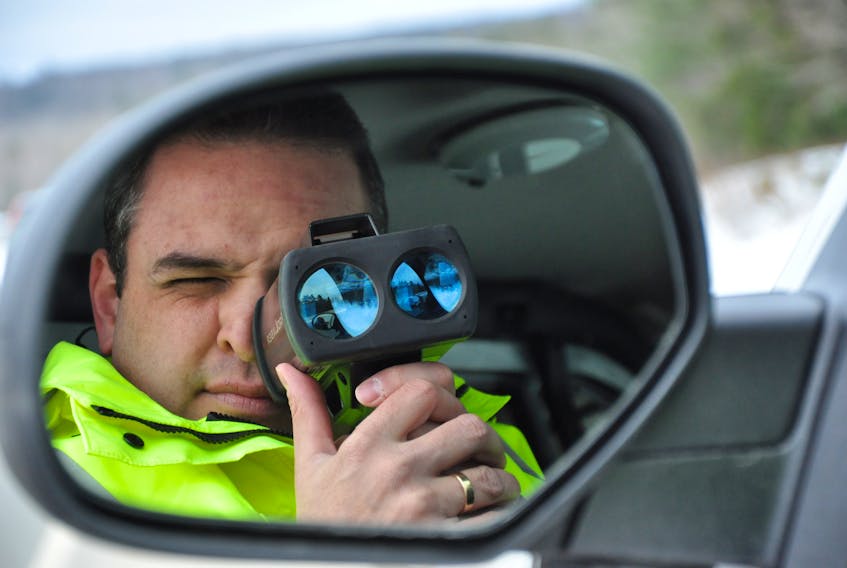
Panic, fear, and worst-case-scenarios whirled through Michael Tops’ head as he ran to help his son and close friend after their motorcycle collided with a pickup truck.
The 2005 accident at the intersection of Brooklyn Street and Lanzy Road in Centreville, Kings County, N.S., could have been worse. Both men survived, but Tops’ friend Eric Payne lost one of his legs and his military career. Tops says the hospital visits also contributed to his family’s decision to relocate from Greenwood to Shearwater.
And all of this is because of the dangerous driving he believes caused the accident.
How Eric Payne found inspiration after amputation
Eric Payne says life “has not been the same” since one of his legs was amputated following a motorcycle accident involving him and the 12-year-old son of his friend Michael Tops.

The accident meant Payne’s 23-year military career was over and was a “dark time” for him.
“There’s an adjustment period that goes on. I don’t want to say it ruined everything and that my life sucked, but it was hard crawling out of that,” he says.
Payne says he’s since “rebounded” and now presents as a motivational speaker through the Soldier On program, aimed at helping Canadian veterans adapt to and live with permanent physical and mental health injuries.
Payne says he’s learned resilience plays a vital role in the recovery of anyone affected by injury, whether as a result of a car accident or otherwise.
“My resilience has helped me face a world that is now totally different for me,” he says.
Payne recalls marking the 10th anniversary with the Tops family in Coldbrook as ‘a special moment’. His experience now “serves as inspiration when I talk to others about what it’s like to be resilient.”
Tops says the two have remained close since the accident, and that regardless of what caused it, placing blame was never a priority.
“The roadway they were on is a road where speeding is a normality – a back road outside of town rarely patrolled by police, in an area where traffic volume is generally low. Both were there at the same time,” says Tops.
“Whether there was a huge intentional component there to be driving dangerous, I can’t say. But, my gut tells me.”
Speeding a factor in insurance averages
Eighty per cent of motor vehicle accidents can be avoided with one more second of response time – but only if motorists are driving at the posted highway speeds, says Gary Howard, vice-president of communications at the Canadian Automobile Association’s Atlantic department.
Once speeding is factored in, drivers have even less time to respond. Despite dangerous driving happening across the Atlantic region, he says there's no certain way to tell which province is most dangerous.
“If you speed, and you have a distraction, you likely would not be able to react as well,” he says.
“It doesn’t take much, especially if speeding, to have a fatality.” —
Gary Howard, vice-president of communications at the Canadian Automobile Association’s Atlantic department
Among the Atlantic provinces, Newfoundland and Labrador has the highest five-year average of speeding tickets from 2013 to 2017 – 29 per 1,000 people – with P.E.I., N.B. and N.S. coming in at 21, 20 and 17 per 1,000 people, respectively.
Newfoundland and Labrador also has the highest average insurance rates in Atlantic Canada, at $1,132. Prince Edward Island has the lowest at $796, with Nova Scotia and New Brunswick in second and third, with averages of $842 and $819.
These higher insurance rates aren’t due only to dangerous driving – rates consider additional factors like a driver’s age and driving record – but also consider claims per capita for all kinds of accidents, says Howard.
“The simple thing is the higher claims means higher risk, means higher premiums. The insurance industry is extremely complex … But in general, the three Maritime provinces are comparable,” he says.
Tops, who works as a project manager and defensive driving expert with Safety Services Nova Scotia, says while he can only speak to Nova Scotia, he’s not at all surprised by what the data shows.
“Do I find these numbers surprising? Not at all – I think they may even be on the low side. Speeding has been normalized in Atlantic Canada,” he says.
Dangerous driving in Atlantic Canada: numbers
Speed and aggressive, or dangerous, drivers are listed together as one of nine key factors contributing to collisions in Canada in a Canadian Council of Motor Transport Administrators’ study called Canada’s Road Safety Strategy 2025.
The study defines these drivers as “driving at speeds beyond posted legal limits or driving too fast for road conditions and driver behaviours which are deemed illegal or outside socially acceptable norms which put other road users at risk.”
Specifically, CCMTA data from its annual Speed and Intersection Safety Management study in 2009 – the most recent found on its website – found 27 per cent of fatalities and 19 per cent of serious collisions involved speeding. It also found 40 per cent of speeding drivers involved in fatal car accidents were between the ages of 16 and 24.
Tops, who is a driver instructor by trade and has taught motorcycle safety training since the 1990s, says he recognizes the roles age and lack of experience can play in such accidents.
He doesn’t feel it was a factor when his son and friend collided with the truck, but rather that speed and “inattentive driving” were more likely to blame.
“Whether (the driver) drifted over, or it was Eric – the long and short of it is both vehicles were at the centre line at the exact same time,” says Tops.
The data also found most drivers killed in these incidents were speeding, and that 80 per cent of passengers killed in a speeding crash had been in the vehicle with a driver the same age.
Data also shows single-vehicle crashes accounted for more than 50 per cent of speeding deaths and injuries, and one in three drivers involved in fatal speeding accidents had been drinking.
CCMTA declined to comment on this story.
Stunting charges

Dangerous driving was also identified as a concern by the Canadian Association of Chiefs of Police in its 2018 Operation Impact, an initiative some provinces took part in to address aggressive driving, impaired driving, distracted driving and seatbelt usage.
Nova Scotia participated, but RCMP public information officer Cpl. Jennifer Clarke says it’s “difficult to assess” what direct impact the initiative has had since it began in October.
Stunting – a charge Nova Scotia drivers face if clocked driving 50 kilometres per hour or more above the lawful rate of speed – is also cause for concern, according to Clarke, who says data shows charges have risen steadily in the province since the law came into effect in 2013.
“Before that law came into effect, someone who was going more than 50 km/h would have received a ticket for speeding, so it's not as if drivers weren't being ticketed for that offence,” she says.
Tops says he’s thankful both Payne and his son survived the accident and says both men feel lucky the incident has only left them physically scarred – Payne now presents as a motivational speaker to other amputees, and Tops’ son owns and drives his own motorcycle.
As for Tops, he now uses the event as a first-hand example of the consequences of dangerous driving and the seconds it removes from a driver’s response time.
“That accident could so easily have taken both their lives,” says Tops.
Increasing numbers
The one province that has seen a regular increase of drivers caught speeding 50 kilometres over posted speed limits is Nova Scotia, which has increased each year since 2013. In what Halifax Regional Police media officer Const. John MacLeod calls an incident “of significant speed and danger to the public,” a Tantallon, N.S. driver was caught driving 162 kilometres per hour over the recommended limit in a Halifax school zone in March 2018.
This was one of 18 stunting tickets issued in Halifax from November 2017 to November 2018, according to data received Nov. 23, 2018.
“Whenever someone chooses to exceed these limits, it places both the occupants of that vehicle in potential danger as well as the rest of the motoring public and pedestrians in the area,” says MacLeod.
Such incidents show Atlantic Canadians still have far to go, says Tops, who sits on the province’s Road Safety Advisory Committee, which he describes as a “think tank” for the transportation department.
Tops says the incident serves as an inspiration to him and others deciding how to best address speeding and dangerous driving that result in these accidents, which often occur due to several factors, he says, including speed, weather, age, and experience.

“There were certainly a multitude of factors when our accident happened – it was a recipe for disaster,” he says.
“A moment of inattention can make a lifetime of difference.”
While road safety remains an identified issue across Canada, Clarke said the one thing police can continue doing is using different tactics – renting cars to use to spot traffic violations or even dressing police as hitchhikers watching for cell phone use – to continue ticketing drivers and relaying why being safe while driving is so important.
She also highlights crucial partnerships, noting the Nova Scotia RCMP often work with municipal police departments, vehicle compliance, and military police to get the job done.
“We will continue to be out there… trying to do our part to improve road safety for Nova Scotia drivers,” says Clarke.
Tops’ family and Payne met up in 2015 in Coldbrook to mark the 10-year anniversary of that life-changing accident. They have dubbed the anniversary ‘Alive Day’ to celebrate that they and their love of motorcycling survived.
“After (the accident), we all still rode. Has it changed the outlook? Sure, and some things are a little more pronounced now – a little more caution used on blind turns,” says Tops.
Read more about our Need for Speed, its risks and consequences









